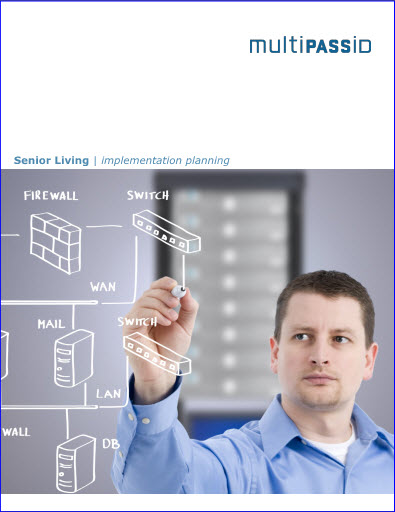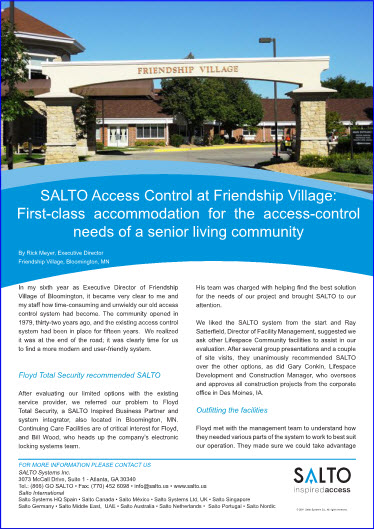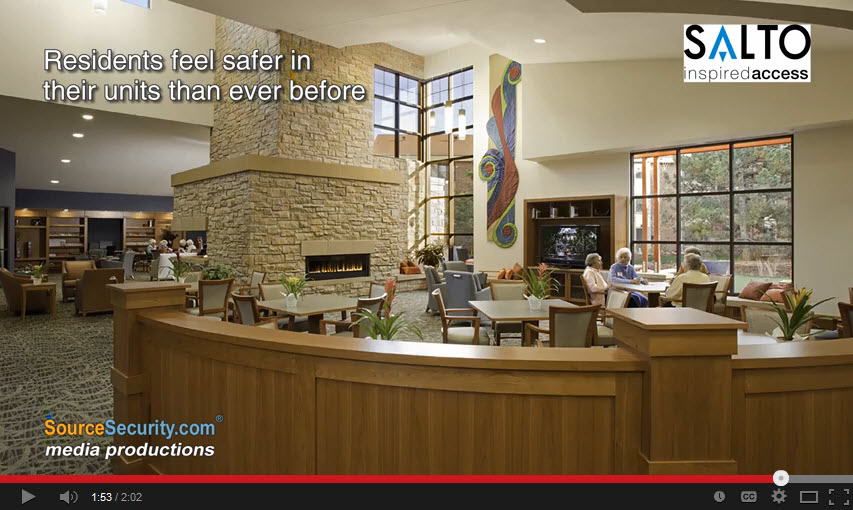reducing operator's risk, enhancing residents lives
We provide greater peace of mind for you, your staff and most importantly, your residents and their families. Executive Directors are extremely thrilled with the return on the investment. They tell us that resident and family satisfaction increases due to the greater sense of security and ease of use. Not only are organizations able to leverage existing investments to differentiate their properties, they are able to compete on the operating cost side of the equation by reducing some of the direct labor that right now has an endless escalation built in.
These services allow you to stay connected and in control whenever, wherever you want.
Ready? Get Started
Return on Investment - Surprisingly Affordable
Physical Access Control - Return on Investment Summary
Mechanical Keys Offline Locks RF Locks Virtual Network Summary
Introduction
A top priority of residents in senior communities is living in a safe and secure environment. Owners and managers of these properties want this too for both residents and staff. The challenge they face is weighing perceived short term savings verses long term strategic investments that provide immense resident/staff satisfaction, market differentiation - revenue generation, operational efficiencies and risk mitigation.Traditional thinking for securing a senior living property is to install hardwired access control to several perimeter doors and old fashion brass mechanical keys on the interior doors and resident units. While this solution works it doesn't position a property for the long term to take advantage of new technology and interoperability with other systems being installed in the building.
A new, proven technology available from multiPASS-iD builds a foundation starting at the resident door. When this smart card, fob or wristband technology is installed on perimeter and interior doors it offers a much greater user experience for both residents and staff. No longer do residents with an unsteady hand have to fight with putting a key into a lock while holding a bag, cane or walker. Employee satisfaction increases with the knowledge they are protected from the emotional stress of finger pointing and false claims of wrong doing. Additionally, this system can work with point of sale, time/attendance tracking and notification systems.
The following are descriptions and return on investment (ROI) calculations between mechanical keys, off-line locks, radio frequency locks and a multiPASS-iD wire free virtual network solution:
Mechanical Keys
Financial implications of physical keys are not readily defined. While it is easy to understand that the act of rekeying a 100 unit facility costs about $5K, that doesn't take into account the distribution and maintenance of the physical keying system itself. At 100 units, staff will spend 16 to 20 hours planning, coordinating and distributing keys to residents and staff members each time they re-key the facility. Even re-keying once every 3 years means on average, a $2K annual expense. That same facility with independent, assisted and memory care will turnover approximately 2 to 3 units per month, requiring keying and provisioning for these is an additional $900 per year. Physical keys cost anywhere from $1.00 to $12.00 each based on type and source. At best, for every 100 units you spend on average $2,900 per year on your mechanical key system, this rises to $4,900 if you use secure non-duplicable restricted keyways like Medeco.One can possess a key cutting machine and the necessary skills to efficiently operate it. Maintaining proper key-holder records doesn't provide control of potential misuse, unauthorized duplication and loss of accountability. Often we find that over time, equipment and records become questionable and that uncertainty leads to distribution of keys without full knowledge of their access. Regularly we see duplication of master keys both purposefully to avoid having the recipient return yet again and unintentionally because of poor record keeping. These types of events are usually only discovered when someone has gained access and the results of which warrant investigation. How often are you investigating access? What does that cost in your environment? As Senior Living and care providers continue to evolve under the new Affordable Care Act, evolving partnerships with hospitals will provide more visibility to items like HIPAA compliance, infection control and tracking. How are you preparing for the scrutiny these more meaningful partnerships will face? What are the potential costs associated with risking your operations to mechanical keys?
Off-Line Locks
Some facilities have worked to mitigate their risks by following the path of hotels and campus housing by replacing mechanical keys with offline locks. While these systems do alleviate the mechanical aspect of cutting keys and re-pinning cores, in all cases operational expenses rise over mechanical keys. Offline locks function based on the privileges data and audit being stored in the lock itself. The necessity to update each effected door physically upon loss or issuance of a credential can create a tremendous burden on management. With mechanical keys, everyone accepts some level of risk due to mishandling prior to making the decision to re-key a facility. With credential based electronic access control these same risks are unacceptable. Users take action each time there is vulnerability to avoid unacceptable risk, therefore spending more time and money because the alternative is not an option. No one would suggest negligence for one misused physical key, with electronics the risk associated with not taking necessary precautions is greater because you have the available means to mitigate it. The same 100 unit facility as above can expect to spend on average $6,000 per year maintaining an offline locking system. When coupled with the capital costs of a typical retro-fit implementation this number rises to $10,000 per year over the expected 15 year lifespan of the system.Radio Frequency (RF) Locks
To offset the high operational costs of offline locking systems, manufacturers have begun introducing RF wireless versions of their products to reduce the time and operating expenses associated with high door count applications like senior living. These systems replace the necessity of physically visiting each door by updating each door via RF radio signals. These RF radios decrease the battery life of each opening and require RF infrastructure to facilitate traffic to each opening. The RF frequencies of these products vary between 900MHz and 2.4GHz like 802.11 and 802.15.4. Implementation requires management of frequency overlap within the facility, as there are many wireless signals in a modern health care environment. Manufacturers have also improved the performance of devices mechanically, upgrading to full Grade 1 hardware compliance when adding these more costly RF interfaces to improve the durability and lifespan of the product to 25 years or more. While infrastructure costs will vary for RF by application, a typical 100 unit facility can expect to spend on average $4,500 per year maintaining an RF wireless enabled locking system. When coupled with the capital costs of a typical retro-fit implementation this number rises to $9,500 per year over the expected 25 year lifespan of the system.Wire Free Virtual Network
multiPASS-iD helps users leverage smart card technology to dramatically reduce the costs associated with electronic access control and increase usability. We deliver wire-free applications intended to lead to an environment without mechanical keys. The solutions utilize the read/write functionality of the credentials and readers to move data around the facility via a virtual network. This disruptive technology is unlike the offline system's reliance on the administrator to physically visit each opening or the installation burden associated with RF wireless communications. Updates, audits and maintenance information are communicated across the system by the virtual network, made up of users moving between "hot-spots" and deferred time readers. Credentials vary from cards, key fobs, stickers or to wristbands and cost about $1.00 to $8.00ea depending on form factor. This game changing technology allows the same 100 unit facility to operate on an average of $2,000 per year. When coupled with the capital costs of a typical retro-fit implementation this number rises to only $6,250 per year over the expected 25 year lifespan of the system.| Resident Unit Options | Annual Maintenance Expense | Annual Maintenance Expense Plus Implementation Capital Cost |
|---|---|---|
| Standard Mechanical Keys | $2,900 | $4,150 |
| Patent Protected Mechanical Keys | $4,900 | $6,150 |
| Traditional Offline Locks | $6,000 | $10,000 |
| Traditional RF Locks | $4,500 | $9,500 |
| Virtual Network | $2,000 | $6,250 |
Typical multiPASS-iD savings over a traditional offline or RF wireless system's expected life to help reduce the risks associated with traditional mechanical keys.
- $93,750 in savings over Traditional Offline Locks
- $81,250 in savings over Traditional RF Locks
Mechanical Keys - Costs & Liabilities
Discovering the Potential Cost and Liabilities of Staying with Mechanical Keys
The financial choice of a multiPASS-iD wire-free implementation is apparent when compared with offline and RF wireless options. A decision to stay with mechanical keys has its own potential costs and liabilities. Today's Senior Living market is becoming increasingly more crowded and competitive to maintain high occupancy and satisfaction rates. Families desire to make a single lifetime decision for the balance of their loved one's needs, both physical and emotional. As family members become more technologically savvy, they expect their parent's environments to mirror that of their own experiences. How do the modern conveniences within your facility compare to a newly constructed competitor? Operationally what are you doing to improve your internal accountability for housekeeping, maintenance, dining and leisure services that lower costs and differentiate your properties from the competition?Personal service, quality of care and food service will always be the benchmark of a good organization, but customers have come to expect that of everyone. Today's baby-boomer is looking for amenities similar to that of a spa or resort that they have experienced to make their loved ones more comfortable. Operators want to provide the best technology services possible to attract and retain residents.
Cost Justification of multiPASS-iD vs Standard Mechanical Keys ...
- Retrofit applications need to find $2,100 in savings per year
- New construction applications need to find $3,125 in savings per year
ROI Example - Efficiency Gains
- Finding an hour improvement gain per week of only 4 staff individuals equals $5,200 per year. One senior living campus discovered a savings of 10 hours per week between two maintenance personnel. A reduction of 95% in time spent managing mechanical keys.
ROI Example - Food Service
- Food Service is a very high expense. Lost meals given away to maintain resident satisfaction is lost revenue. A food service budget for a 100 unit location can easily be $800,000. Recovering a conservative 1% of the budget equals $8,000 per year. One senior living campus with multiPASS-iD expects to recapture 5% to 10% of their food service budget plus 2 to 4 hours per week of a staff person's time reconciling accounts.
ROI Example - What is the value of resident satisfaction?
- multiPASS-iD solutions provide ease of use and improve resident satisfaction. The locking solutions are also seen as an added level of security for family members. Because they provide audit and tracking, they dramatically lower the stress associated with missing personal belongings. Audit reports are reviewed upon incident, providing a clearer path of investigation and assurance to the resident of their safety and security. What is the resident's feeling of personal security worth? How do you account for activities that take place within a resident's unit during extended leaves or vacations? How do you provide assurance to the power of attorney that the resident's belongings have not been disturbed?
ROI Example - Cost of employee turnover?
- One claim of theft can lead to a firestorm of resident activity aimed at a particular staff member. What steps have you taken to help alleviate these pressures? With the looming Caregiver shortage it is hard to fill certain staff positions today. What are you doing to keep the good people you have? What does replacing a single good staff member cost you? You can never really control what experiences leave your facility through word of mouth. If one incident created a bias against your facility with a potential resident, what does that cost you? Electronic access control helps to mitigate the risk of these incidents occurring in the first place.









